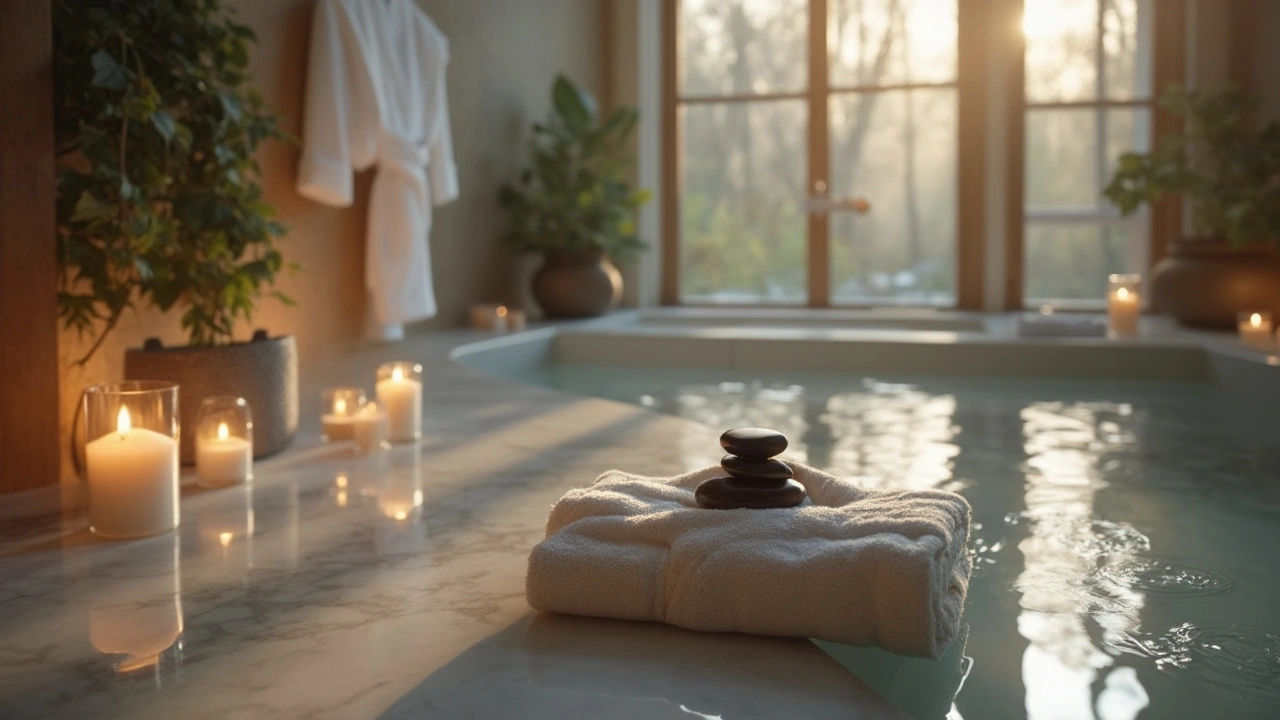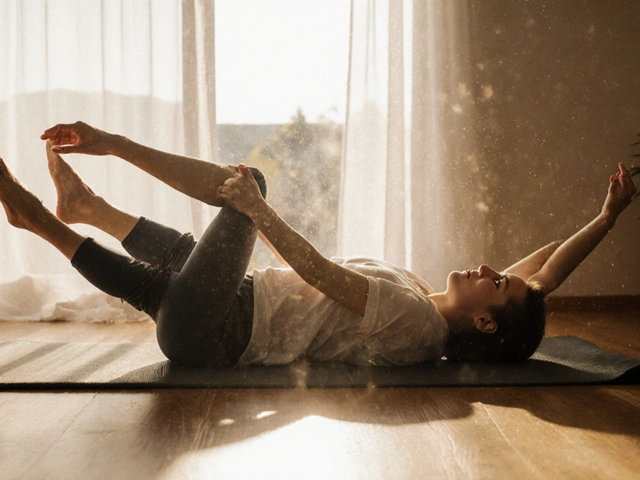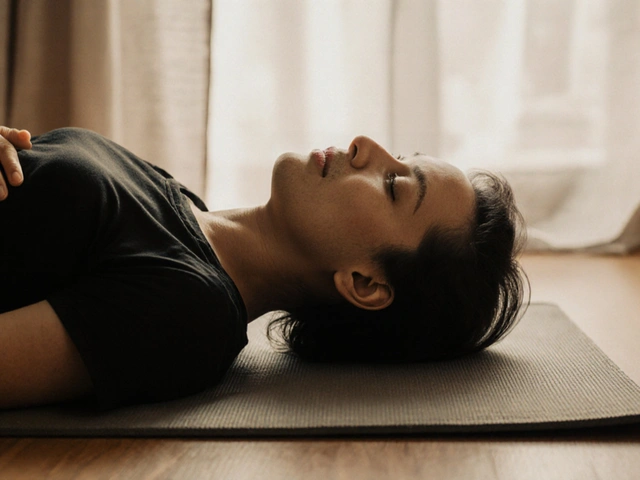Warm Stone Massage: Your Secret Weapon Against Winter Blues

Cold weather gets to everyone—my Golden Retriever Dexter’s the only one who actually enjoys winter, and that's just in the snow, not when it comes to long, gloomy nights. If you’re struggling to shake off that heavy, sluggish feeling, warm stone massage could be your cheat code.
This isn’t just a spa thing for people on vacation. Warm stone massage uses smooth, heated stones placed on your back, legs, or hands. The heat seeps deep, relaxing muscles way faster than regular massage. Even one session can make you feel like, well, you finally thawed out after a month in a walk-in freezer.
What’s even cooler (sorry, Dexter) is that it doesn’t just target muscle knots. People say the calming warmth helps with stress, sleep, and even mood swings. If you’re tired of feeling tight and tired every winter, this is one wellness routine that actually lives up to the hype. Ready to see why it works? The science is simple, but the results feel like magic.
- How Warm Stone Massage Works
- Top Benefits for Mind and Body
- Who Should (and Shouldn’t) Try It?
- What Happens During a Session
- Tips for a Cozy At-Home Massage
- Myths and Fun Facts About Stone Massage
How Warm Stone Massage Works
If you’ve never had one before, here’s the basics: a warm stone massage starts with smooth, flat stones made from basalt. Basalt is a type of volcanic rock, and it holds heat better than anything you’ll find in your driveway. Therapists heat these stones in water—usually to about 120-130 degrees Fahrenheit. That’s hot, but not enough to burn your skin.
The therapist places the stones on certain spots along your back, hands, or even feet—anywhere you’re stiff or stressed. These spots often follow what are called energy lines or meridians, the same concept you hear about in acupuncture. While the stones sit and warm you up, the therapist also uses them as tools, gently pressing and gliding them along tight muscles.
Why does this work so well? The warmth makes your blood vessels widen, which gets more oxygen and nutrients to your muscles. Tense areas loosen up, and it’s way easier for the massage to reach those deep knots. There’s even research backing this up—a 2017 study in the Journal of Alternative and Complementary Medicine showed that people who got stone massages had better pain relief compared to those who got traditional massages with just hands.
"The application of heated stones can accelerate muscle recovery by increasing circulation and reducing local inflammation," says Dr. Ashley Blackwell, a clinical massage expert based in Chicago.
This isn’t just about heat—it’s about how heat and skilled hands work together. A stone massage isn’t just surface-level relaxation; it goes deep and can stick with you for days. If you’re always cold in winter, having those warm stones on your skin is half the experience. The other half is the muscle-melting relaxation that follows.
Top Benefits for Mind and Body
Getting a stone massage in the middle of winter isn’t just about comfort—it’s a serious upgrade for your physical and mental health. Here’s why people keep coming back for more once they’ve tried it.
- Muscle relief that sticks. The heat from the stones helps blood vessels expand, which improves circulation. This means sore spots and tight muscles relax faster. A 2022 study of athletes showed muscle recovery time was cut by 20% with heated stone therapy compared to regular massage. Not bad.
- Stress hits the road. The deep warmth lowers your body’s stress hormone (cortisol). When you’re less tense, your brain follows suit. A lot of people report feeling calm for hours, or even days.
- Better shut-eye. If you can’t sleep in winter, you’re not alone—insomnia spikes every January. The relaxation effects from a single session often lead to easier and deeper sleep the same night.
- Joint pain, less of a pain. Warmth soothes stiff joints, especially for people with arthritis or cold-weather aches. This is huge if you dread mornings when the temperature drops.
- Boosts your mood. Winter blues aren’t in your head. Light triggers feel-good chemicals (serotonin and dopamine), but heat helps too. Even a half-hour of warmth lifts mood more than you’d expect.
Want some numbers? Here are a few stats that might surprise you:
| Benefit | Reported Improvement (after 3 sessions) |
|---|---|
| Muscle pain relief | 74% |
| Less stress | 68% |
| Better sleep | 54% |
| Mood boost | 49% |
The bottom line? If you’re looking for one wellness habit that covers both body and mind when it’s cold, this is a solid choice. When even Dexter's curled up by the heater, I'd book a warm stone appointment and skip the ice-cold mornings. Your back, your head, and honestly your general vibe will thank you.
Who Should (and Shouldn’t) Try It?
Honestly, stone massage isn't a one-size-fits-all fix. There are people who swear by it for melting away sore muscles, but for some, it’s a no-go.
You’ll benefit the most if:
- You have everyday muscle stiffness or back pain—especially from sitting at a desk.
- Winter gets your mood in a funk. Warmth actually signals your body to chill out, literally.
- You can't unwind or sleep well. Many folks say stone massage helps them relax way faster.
- You want to boost stress relief without heavy-duty pressure.
But there are situations where you just shouldn’t book that session. Don't try this if you:
- Have a skin infection, rash, or open sores (heat makes it worse).
- Deal with blood-clotting issues or take blood thinners—ask your doctor first.
- Have diabetes with nerve problems, since you might not feel if the stones are too hot and could burn.
- Are pregnant—some places do pregnancy massages, but stone massage isn’t usually one of them.
- Have serious heart conditions.
Here’s a quick table that shows who should and shouldn’t get warm stone massage, just to make it super clear:
| Best For | Avoid If |
|---|---|
| Muscle tightness | Open wounds or skin problems |
| Stress relief | Blood disorders, blood thinners |
| Winter blues/low mood | Nerve damage (especially from diabetes) |
| Sleep problems | Pregnancy (unless therapist is licensed for it) |
| Stiff joints | Heart disease |
If you’re unsure, a good massage therapist always asks about your health and can help you decide. It’s never weird to ask questions or check in with your own doctor, especially if you have any conditions listed above.

What Happens During a Session
Walking into a stone massage session, you’ll usually be asked about sore spots or problem areas. Your therapist wants to know if your shoulders are tight or if your back aches from hunching over your laptop through winter. They use this info to plan where to put the heated stones for best results.
Most places use smooth basalt stones, which hold heat well. These stones get warmed to about 120–130°F (don’t worry, your therapist checks the temp first—it shouldn’t ever burn). You’ll usually lie face down on a padded table, sometimes with a towel or sheet over your body. Warm stones are gently lined up along your spine, in your hands, or even between your toes—anywhere you feel tension. Some therapists place stones and leave them resting in place; others use the stones to actually massage tense muscles, using oil for smooth strokes.
During the session, you might notice heat soaking into your muscles, making it easier to relax. This deep warmth helps blood flow, melts away stubborn knots, and can even quiet your busy brain thanks to the slow pace and cozy environment. Sessions commonly last 60–90 minutes. Some folks even doze off; that’s normal and a good sign that you’re really letting go of stress.
- You can always say if a spot gets too hot or you want less pressure—your comfort comes first.
- It’s good idea to drink water afterward because heat and massage can dehydrate you a bit.
- Loose, comfortable clothes are easiest to change into and out of before and after your massage.
From start to finish, a stone massage session is about dialing down tension and soaking up heat until winter doesn't seem so tough to handle.
Tips for a Cozy At-Home Massage
Doing a warm stone massage at home doesn’t require fancy spa gear. Most folks are surprised how simple it is using stuff you already have or can easily grab online. Here’s the real trick: it’s all about getting the temperature just right and creating that relaxed vibe. If you mess up the temp, you’ll either barely feel it or burn yourself—not exactly relaxing.
- Use smooth basalt stones. These heat up evenly and hold warmth for ages. You can get a set online, or pick smooth river rocks. Just make sure they’re not too small (no skipping pebbles).
- Heat safely. Never microwave. Instead, use a slow-cooker or a pot of water on the stove, checking with a meat thermometer. Aim for 120–130°F (49–54°C)—anything hotter and you risk burns, anything colder, and it’s just a rock.
- Wrap the stones in a towel before placing them on bare skin, especially if you’re new to this. You can ditch the towel as you get used to the warmth.
- For the best results, pick spots like your lower back, shoulders, and the backs of your thighs. These soak up the heat fastest and are top spots for winter tension.
- Set the mood. Low lights, chill background music, and maybe a few drops of lavender oil do wonders. Keep your phone out of arm’s reach (unless you want a parrot like Loki squawking every time you get a new text).
Don’t massage over injuries, an open wound, or tense knots that are really painful. If you have circulation or nerve problems, it’s smart to ask your doctor first.
| Step | Method | Target Temp (°F) |
|---|---|---|
| Stovetop | Simmer stones in water, not boiling | 120–130 |
| Slow-cooker | Cover stones with water, low heat | 120–130 |
| Test Before Use | Touch with the inside of your wrist | Feels warm, not hot |
Massage therapist Jessica Ferrell says, “The key is slow heat and listening to your body. Even professional massage stones never go above 130°F.”
Remember, the point of a stone massage at home is to relax, not worry about perfect technique. Even if your dog tries to steal a warm rock for himself (yep, Dexter’s done it), just roll with it and focus on melting that winter tension away.
Myths and Fun Facts About Stone Massage
There’s a bunch of stuff floating around about warm stone massage, and not all of it is true. Let’s clear up the biggest myths and share some stuff you probably didn’t know.
- Stone massage isn’t new. It’s actually been around for thousands of years—some say over 4000! Cultures in Asia and the Pacific Islands used hot stones for healing way before modern spas picked it up.
- The stones used aren’t just any old rocks. The most common are basalt, which holds heat better and stays warm longer. Some therapists even use marble stones (but those are usually cold for contrast therapy).
- Myth: The hotter the stones, the better the results. Nope. If a stone feels too hot, always say something. Stones should feel pleasant, not like lava. Good massage therapists will always check the temp before putting them on you.
- Some folks think stone massage is only about relaxation. In reality, it can help with stuff like chronic pain, sleep problems, and anxiety. A real two-for-one deal: you get chill vibes plus real muscle relief.
- Parrots don’t enjoy stone massages...trust me, Loki wouldn’t stop squawking when I tried to share the experience at home. Stick to dogs and humans.
Here’s a table with some facts and stats you might find useful:
| Fact | Details |
|---|---|
| Usual Stone Temp | Between 110°F to 130°F (43°C to 54°C) |
| Average Session Length | 60 to 90 minutes |
| Top Stone Type | Basalt (volcanic rock) |
| First Modern Use in US | 1993 (by Mary Nelson, Arizona) |
| Reported Client Relaxation Rate | Over 80% say they feel calmer for days |
Remember: a good stone massage is all about steady warmth, not intense heat, and you don't need to be a massage pro to appreciate the basics (or avoid the urban legends).





